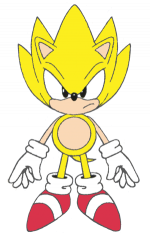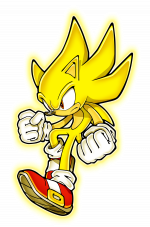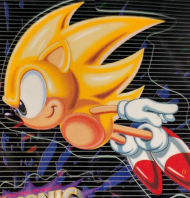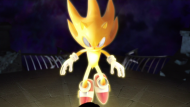Super Sonic
From Sonic Retro

|
This article needs cleanup. This article needs to be edited to conform to a higher standard of article quality. Specifically, issues with this article are:
After the article has been cleaned up, you may remove this message. See How to Edit a Page for help. |
| Super Sonic |
|---|
| First seen: Sonic the Hedgehog 2 (1992) |
| Power source: Chaos Emeralds |
| Base character: Sonic the Hedgehog |
| Used in: Games, Comics, Sonic X, Sonic the Hedgehog 2 (film) |
- For the unreleased game known as "Super Sonic", see Sonic the Hedgehog 2 CD.
Super Sonic (スーパーソニック) is the super form of the character Sonic the Hedgehog. This version of Sonic was first introduced in the game Sonic the Hedgehog 2 and has been featured in some capacity in every main Sonic game thereafter, except for Sonic CD.
Contents
Character conception
The secondary task in the original Sonic the Hedgehog for the Sega Mega Drive is to collect all of six Chaos Emeralds. However, doing so nets the player little more than a slightly different ending - for the sequel, it was decided at some stage to present a new gameplay mode. Given that Chaos Emeralds are collected in a different way in Sonic 2 (by using Star Posts, the player can theoretically collect them all before leaving Emerald Hill Zone), the concept of "Super Sonic", being able to play through the game with increased speed and invincibility was born.
Super Sonic could have initially been described as a joke character. His design is a nod to the popular Japanese manga and anime series, Dragon Ball, in which the main character, Son Goku, transformed into a "Super Saiyan" when battling the tyrant Freeza. Super Saiyans, which became a staple of the series from their introduction in the summer of 1991, are depicted in the series as having long, spiky golden hair and green eyes, and are immensely more powerful than their non-Super counterparts. In Sonic the Hedgehog 2, Super Sonic shares a similar design (complete with more muscular physique), though the green eyes did not emerge until Sonic the Hedgehog 3.
At the time of Sonic 2's release, however, Dragon Ball had yet to take off in the Western world, meaning unlike Japan, the audience there would have been largely unaware of the connection. Sonic 3 and Sonic & Knuckles established Super Sonic as being an integral part of the series' canon, with the form featuring in many Sonic games to date. Over time, Super Sonic's design has veered away from its Dragon Ball roots, with Sonic Adventure changing his eyes to red, and his spikes taking a slightly different shape.
The established lore dictates that if Sonic the Hedgehog possesses all seven chaos emeralds and at least fifty Rings (although this is not always a requirement), Sonic can transform into Super Sonic. While material such as the Sonic the Hedgehog Bible hinted at there being seven emeralds well before Super Sonic's creation, the fact that only six are obtainable in the first game has since been suggested as the reason Sonic could not transform earlier on.
Appearances
Video games
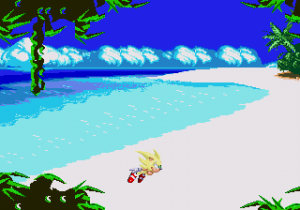
In Sonic the Hedgehog 2, Super Sonic is established as being able to run faster, jump heigher and being nigh invulnerable to most forms of attack. The mode is similar to obtaining both Power Sneakers and Invincibility, however rather than being strictly time-limited, Sonic can maintain his super state as long as he has at least one ring. As Super Sonic, the ring counter decreases every second (although the way it is calculated means the player actually gets a minimum of 51 seconds rather than 50). Sonic will automatically return to his normal state when finishing a level, or if the ring counter reaches zero.
Many games, notably Sonic 3 and Sonic & Knuckles follow a similar design, however the latter goes one step further, allowing players to visit the Super Sonic-only The Doomsday Zone (and thus see the true ending) if Super Sonic is unlocked. The Doomsday Zone demonstrates another recurring feature of Super Sonic - being used in an environment unsuitable for Sonic in his normal form, to take on a final boss.
Outside of bugs, it is still possible to die while playing as Super Sonic. Super Sonic can still be crushed, fall into bottomless pits and drown if kept underwater for too long without air (although some games such as Sonic the Hedgehog 4 Episode I ignore the latter). Extra care was also needed when designing levels, as Super Sonic's abilities allow him to get to areas that other characters can't reach. One infamous example of this is the second act of Mystic Cave Zone, where a if a player lands in a pit lined with spikes, they will have to wait until the ring counter reaches zero until Sonic dies.
Presumed difficulties in programming Super Sonic to play nicely during normal play is thought to be the reason why, at the turn of the millennium, it was decided to restrict Super Sonic's appearances to final bosses or special events. Sonic Adventure was the first game to try this - while unused content suggests Super Sonic was at one point playable in normal levels, in the final game he is only seen when fighting Perfect Chaos at the end of the game. A similar approach was used in most 3D Sonic games for the following decade (and 2D games such as Sonic Pocket Adventure and Sonic Advance), with the Chaos Emeralds being used as a plot device rather than being freely collectable.

|
This article needs cleanup. This article needs to be edited to conform to a higher standard of article quality. |
Even though Super Sonic featured in the above titles, the Chaos Emeralds were used as a critical plot device, removing the ability to collect them at your own leisure. Because of this, the ability to play through the regular game as Super Sonic was also removed, for a time only Sonic 2, Sonic 3 and Sonic & Knuckles being the only main titles where collecting all seven Chaos Emeralds, fifty rings and pressing jump twice (or with Sonic 2, only once) would let Sonic become Super. However, with the release of Sonic 4 and Sonic Colours, this function has been restored to the main line of games. Colours, which is also Sonic's first 3D title to let the player use Super Sonic whenever they choose, does require an additional set of challenges to be met before Super can be unlocked, the need to collect all the hidden Red Star Rings in the game necessary, which unlock stages in the game's Sonic Simulator. Beating all the zones of each stage rewards you a Chaos Emerald. Once they are all collected, a Super Sonic mode becomes available within the "Options Satellite," which must be enabled if the player wants to ability to turn into Sonic's super form in the levels. With the yellow hued hedgehog now visible in the game's overworld, fifty rings are all that is needed to speed through each zone, a musical chime replacing the zone's music just as in the classic titles. The area where the Wisp power-up meter would be is replaced with an image of the seven Chaos Emeralds (though in Game Land replaces it with an un-textured icon due to the fact that Virtual Hedgehogs cannot natively transform into Super Sonic even if it's unlocked, especially areas where Color Powers have to be used would be impossible to cross using Super Sonic), Sonic unable to use any Wisp power in either form, the levels slightly modified to reflect this. While Super, Sonic has an unlimited Sonic Boost, a single jump as high as his double in standard form, and is able to break blocks that are normally needed with a Wisp. It should be noted that, for these two games that have restored Super Sonic as an in-game bonus, there is no "Super Sonic fights the final boss" encounter. Sonic Lost World and Sonic Forces follows Sonic Colors's trend of Super Sonic not factoring into the plot and simply being a bonus feature, with Lost World requiring the player to collect all the Red Star Rings in the Wii U/PC version or completing Special Stages in the 3DS version, and Forces requiring the player to download DLC to enable Super Sonic.
Super Sonic has also appeared in a number of spin-off games, often times as a secret "unlockable character." The racing game Sonic R makes Super Sonic the hardest character to collect, needing to acquire the seven Chaos Emeralds which are hidden on the first four tracks, then needing to place first in each race once finding them. If placed second or lower, the game will unceremoniously state the emerald was not won, the player needing to try their hand at the race once more. Once unlocked, the character proves to be much faster than any other character, with the ability to hover over water with the slightest acceleration. Along with his towering double-jump, the character proves to be the most effective in the game, at the same time disrupting the balance the other characters have with each other.
The Riders racing trilogy (Sonic Riders, Sonic Riders: Zero Gravity and Sonic Free Riders) also feature a playable Super Sonic, marked in game as the "Chaos Emerald Gear." In the first Riders game, Sonic immediately transforms, although he only starts off with thirty rings. Though he has infinite air and all three attributes (Speed, Flight and Power) Sonic uses up rings at a far greater rate when drifting, boosting or attacking opponents, although such actions as grinding will cause the ring counter to freeze momentarily. If Sonic runs out of rings, he takes to running on foot until he can collect more. In the sequel, Sonic begins with zero rings, needing to collect at least one before he transforms into his super state. Having the rings deplete at a much slower rate than in the first, the player has more than enough time to build up their supply, though using the gravity control ability causes rings to quickly deplete at a multiplied rate, making it almost impractical to use. However, if Super Sonic collects at least 60 rings, he enters a permanent boost mode.
The arcade game Sonic the Fighters has Super Sonic appear as the only secret unlockable character, only accessible in the second round of Sonic's fight with Metal Sonic. If Sonic is able to successfully win each round and not lose once up to that point, pressing back, punch and kick at the same time will cause Sonic to transform, becoming invincible as he confronts Metal once more and, in the end, Dr. Eggman. In the party game Sonic Shuffle for the Dreamcast, the transformed state of Sonic is an unlockable character, done by purchasing the bottom right picture in Sonic's photo album. His special move ability is the "Light Speed Spin Dash", which allows double the spaces moved when the same number is played twice in a row, which can be chained indefinitely if the right cards are played. His battle ability is "Sonic Rumble" where the roulette only contains the values four to six.
Finally, the Super Sonic transformation is accessible as a "special move" in such games as Sega Superstars Tennis, Sonic & Sega All-Stars Racing, and the Nintendo games Super Smash Bros. Brawl, Super Smash Bros. for Nintendo 3DS / Wii U and Super Smash Bros. Ultimate as his "Final Smash."
Sonic Frontiers
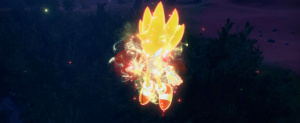
| |
Main article: Starfall Super Sonic |
In other media
Sonic the Hedgehog (Archie comics)
Super Sonic made his first appearance in the Sonic the Hedgehog comic series by Archie Comics in issue #4. With the Knothole Freedom Fighters fighting against a robot calling itself the "Universalamander," Sonic the Hedgehog turned to the reader, asking them to help him out as he ran through the Special Stage to unlock the power of Super Sonic, using seven Chaos Emeralds and fifty rings he just "recently" collected. Although subsequent appearances would not play off the Adventures of Sonic the Hedgehog-esque nature of the early issues, it was established that Sonic's ability to transform into Super Sonic was made far easier by the fact that, on the planet Mobius, an untold number of Chaos Emeralds existed, each with a distinct green hue. This was made clear in the special Super Sonic vs Hyper Knuckles, where Sonic and Knuckles the Echidna raced through a special zone to gather rings and emeralds to transform in an ill-conceived brawl, numerous more emeralds floating out that were unused by the pair. It was also shown, in issue #56, that Sonic did not necessarily need the 7 Emerald/50 Ring combination, able to transform strictly by using previous ring energy and the attacks of Mammoth Mogul. The number of Chaos Emeralds were eventually consolidated into the traditional seven found in the games in issue #169, once again establishing the scarcity of the Super Sonic transformation. However, in issue #184, it was also established that, if need be, Sonic could transform by using the powers of the Master Emerald.
Before the consolidation of the emeralds, a story arc with Sonic stranded in space found him on a planet that did not have green but red Chaos Emeralds. Trying to save an alien race under attack in issue #126, Sonic attempted to use the red emeralds, but instead of transforming, a separate Super Sonic entity was created, an evil version only interested in power and destruction. Having destroyed the threat that the planet was facing, the evil Super Sonic turned its attention to the defenseless inhabitants, Sonic forced to go up against this powered version of himself. Just like Super Sonic, though, the evil alternate could only exist for a limited duration, disappearing once his energy was used up; Sonic distracted the being long enough for this to happen, in order to prevent any further damage.
As the world was reset in the events of Sonic: Genesis (Sonic the Hedgehog #226-229), Sonic lost his knowledge of Super Sonic, until, while in his final battle with Eggman in the Chaos Emerald-charged Death Egg, Sonic absorbed the power of the seven Emeralds through a dislodged power cable, gaining his Super form and defeating Eggman. After doing so, in order to save the planet from being torn apart by seismic activity, Sonic channeled the power of his form in order to perform Chaos Control and revert the world to its natural state.
During the events of Worlds Collide, Sonic, alongside Mega Man, turned Super once again in order to combat the Egg-Wily Machine X and the imminent Super Genesis Wave. Although they were successful in destroying the machine, the Super Genesis Wave had already begun. Super Sonic prepared Chaos Control to again fix the universe, but Eggman interrupted him, irreparably altering the multiverse. In the post-SGW universe, Super Sonic appeared again in Sonic the Hedgehog #286-7, wielding the seven Emeralds in combat against Perfect Dark Gaia in the resolution of the Shattered World Saga (an adaptation of Sonic Unleashed.)
Super Sonic again made an appearance in Worlds Unite (Sonic the Hedgehog #275 and Mega Man #52), fighting alongside Mega Man against Sigma-3, and was unable to properly damage him until Eggman and Wily interfered behind the scenes. After Sigma's defeat, Sonic prepared Chaos Control yet again to save the multiverse from annihilation, but this time, was unable to properly execute it, as the multiverse was too broken for Chaos Control to work.
In the epilogue of Worlds Unite, Sticks the Badger is telling her versions of Sonic and friends about the events of the crossover, and upon the mention of Super Sonic, Boom Sonic doubts he could ever do something like that, implying the Chaos Emeralds have little to no relevance in the Archie Boomiverse.
Sonic the Comic
| |
Main article: Super Sonic (Sonic the Comic) |
In Sonic the Comic, Super Sonic takes on an entirely different persona, being an uncontrollable, almost demon-like force that aims to destroy all living things. Sonic transforms into Super Sonic when under great stress or exposed to "chaos energy", though only for short bursts.
Such was the terror of Super Sonic that for much of the series, the demon was separated from Sonic, causing havoc in the Special Zone until trapped by the Omni-Viewer. He eventually escaped but was hit with a bout of ammnesia, spending the latter half of the series trying to adapt to normal life with newly found friends Ebony and Pyjamas. In the last story Super Sonic returns to Mobius, finds the Chaos Creature and becomes evil again, however Ebony manages to merge him back into Sonic, returning to the series' original status quo.
Sonic X
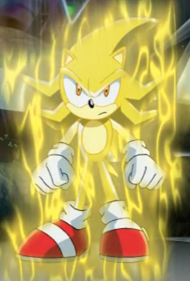
Presented in a similar manner to how he is depicted in the games, Super Sonic is once again the fully-powered form of Sonic, done through the use of the seven Chaos Emeralds. First appearing in "The Birth of Super Sonic," the appearance of this super form allowed the first major story arc of the show to complete, stopping Eggman's latest plan. This first appearance also showcases an ability of Super Sonic's exclusive to the show. During the course of the episode, Chris Thorndyke, who was the first person to befriend Sonic after the universal jump in episode one, became wounded. Noticing this, Super Sonic was able to heal the boy, something no other version of Super Sonic has been shown to do. The transformed state would later show up in the adaptations of Sonic Adventure and Sonic Adventure 2, used in nearly the same capacity as in the games. Super Sonic would also appear at the end of the first series, saving Tails from the "Grand Egg Imperial," and would later return during the course of the second series in the fight against the Metarex.
One episode of the series, "The Black Trap," also featured a variant on the "evil Super Sonic" motif. Called Dark Super Sonic, this chaotic version of the character appeared when Sonic accidentally channeled his anger through a set of fake Chaos Emeralds. It was only when Dr. Eggman talked to Dark Super Sonic and explained that Sonic is usually "much better than this" that Sonic was able to return to his natural state.
Sonic the Hedgehog (IDW comics)
Super Sonic first appears in Sonic the Hedgehog #29. Sonic and Silver use the seven Chaos Emeralds to transform into their super forms in order to defeat Zavok. The two super hedgehogs then rid the world of the Metal Virus using the Warp Topaz and Silver's psychokinesis to send the Metal Virus into the Sun. However the Warp Topaz isn't able to handle Super Sonic and Super Silver's power and overloads. Super Sonic tried to ditch it in the super warp portal but ended up trapped in the Sol Dimension without the Chaos Emeralds.
Sonic the Hedgehog (film series)
| |
This short section needs expansion. You can help Sonic Retro by adding to it. |
Appearances
Video games
- Sonic the Hedgehog 2
- Sonic the Hedgehog 3
- Sonic & Knuckles
- Sonic the Fighters
- Sonic R
- Sonic Adventure/DX
- Sonic Pocket Adventure
- Sonic Shuffle
- Sonic Adventure 2/Battle
- Sonic Advance
- Sonic Advance 2
- Sonic Heroes
- Sonic Advance 3
- Sonic Rush
- Sonic Riders
- Sonic the Hedgehog (2006)
- Sonic Rush Adventure
- Sonic Riders: Zero Gravity
- Super Smash Bros. Brawl
- Sonic Chronicles: The Dark Brotherhood
- Sonic Unleashed
- Sonic & Sega All-Stars Racing
- Sonic the Hedgehog 4 Episode I
- Sonic the Hedgehog 4 Episode II
- Sonic Free Riders
- Sonic Colours
- Sonic Generations
- Sonic Dash/Plus
- Sonic Lost World
- Super Smash Bros. for Nintendo 3DS / Wii U
- Lego Dimensions
- Sonic Mania/Plus
- Sonic Forces
- Sonic Forces: Speed Battle
- Super Smash Bros. Ultimate
- Sonic Frontiers
- Sonic Origins/Plus
- Sonic Superstars
Television Series and Film
- Sonic X (Anime, Japan)
- Sonic the Hedgehog 2(film)
Comic Books
- Sonic the Hedgehog (Archie Comics, US)
- Sonic the Comic (Fleetway, UK)
Miscellaneous
| |
Trivia sections are bad Try and incorporate this information into the main article. See the manual of style to find out why. |
|---|
- There are a handful of games that, although Super Sonic does not feature within, have hints and clues that he was indeed meant to show up in some capacity. In the Sega 32X game Chaotix, a single frame of a Super Sonic sprite was uncovered within the game, though it is unused.
- Found in the audio files of Sonic Adventure, a short clip of Tikal exists where she explains that if the player collects fifty rings and presses jump twice, they can transform into Super Sonic. As this process is not needed to play as Super's only appearance in the game, and the hint is unused in the released version, it is believed that Super Sonic was meant to be playable in the same fashion as he was in the classic games, but was removed at the last minute.
- Exploring the workings of the 2006 Sonic the Hedgehog uncovered a "Rainbow Gem" item that was originally intended to be a purchasable item, but was not implemented in the final release. When attempting to execute the programming connected to the gem, Sonic uses an animation not featured elsewhere, in which he levitates for a moment, spins in the air, and his spikes move up as if he were about to transform. This has led many people to believe that Super Sonic was originally intended to be playable through the main levels of the game, not just the final boss encounter.
References
